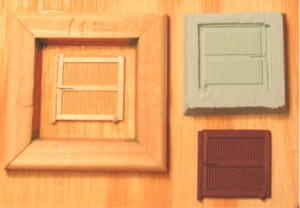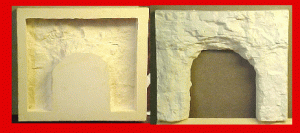I've not seen much discussion here about casting parts with resin in RTV molds. I'd really like to encourage you scratchers and bashers to try it if you haven't.
The photo shows my first stab at it. I was amazed at how easy it was, how my first attempt came off without a hitch, and how perfect this is for creating multiple copies of those parts you can't find or can't afford. I used the RTV and resin sold by Micro-Mark. I simply followed the brief and clear instructions.
This is a box car door. I made 2 RTV molds so I could pour 2 parts at a time, cast 10 doors, and all but 1 came out perfectly. The molds show no deterioration. I imagine I could cast 50 or 100 parts in each --- if I wanted to. I reiterate: This was my first attempt at resin casting. If I did it so easily, anyone can. I'm planning now to cast an entire box car!
The photo is self explanatory: At the left is the original pattern (with a low "box" added around it to retain the RTV.) The pattern was made of wood, a little bit of paper, a little cardboard, and some paper clip wire. I sealed it with spray shellac.
On the upper right is the RTV mold that I had poured onto the pattern. The lower right is one of the cast doors, painted.
The photo shows my first stab at it. I was amazed at how easy it was, how my first attempt came off without a hitch, and how perfect this is for creating multiple copies of those parts you can't find or can't afford. I used the RTV and resin sold by Micro-Mark. I simply followed the brief and clear instructions.
This is a box car door. I made 2 RTV molds so I could pour 2 parts at a time, cast 10 doors, and all but 1 came out perfectly. The molds show no deterioration. I imagine I could cast 50 or 100 parts in each --- if I wanted to. I reiterate: This was my first attempt at resin casting. If I did it so easily, anyone can. I'm planning now to cast an entire box car!
The photo is self explanatory: At the left is the original pattern (with a low "box" added around it to retain the RTV.) The pattern was made of wood, a little bit of paper, a little cardboard, and some paper clip wire. I sealed it with spray shellac.
On the upper right is the RTV mold that I had poured onto the pattern. The lower right is one of the cast doors, painted.




